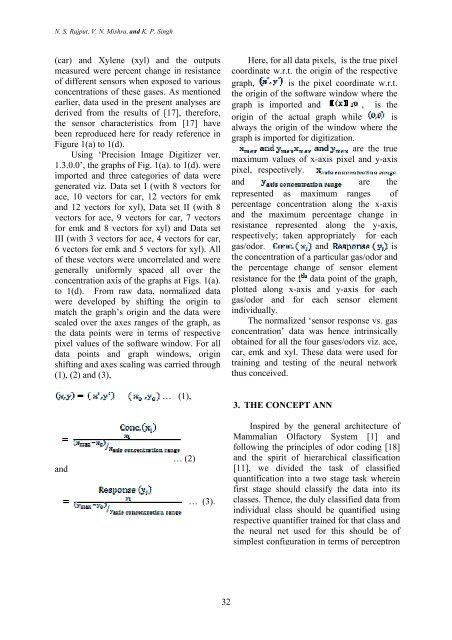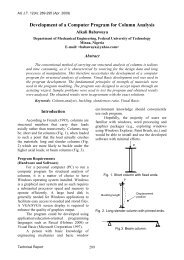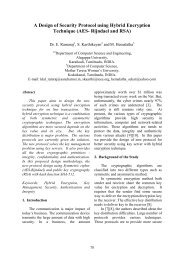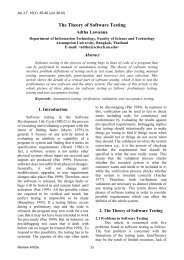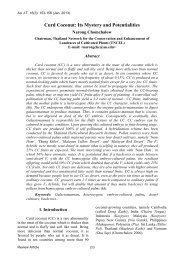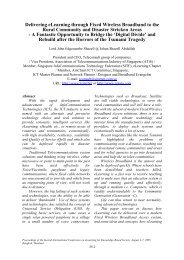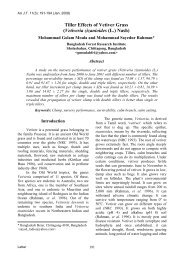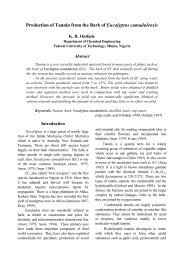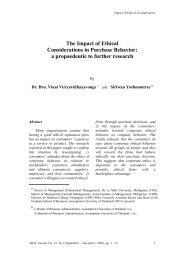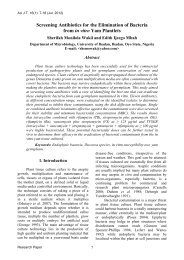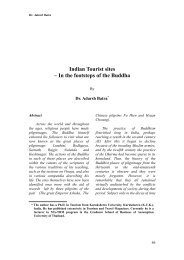A Reduced Complexity Two-Stage Neural Classifier for ... - AU Journal
A Reduced Complexity Two-Stage Neural Classifier for ... - AU Journal
A Reduced Complexity Two-Stage Neural Classifier for ... - AU Journal
Create successful ePaper yourself
Turn your PDF publications into a flip-book with our unique Google optimized e-Paper software.
N. S. Rajput, V. N. Mishra, and K. P. Singh<br />
(car) and Xylene (xyl) and the outputs<br />
measured were percent change in resistance<br />
of different sensors when exposed to various<br />
concentrations of these gases. As mentioned<br />
earlier, data used in the present analyses are<br />
derived from the results of [17], there<strong>for</strong>e,<br />
the sensor characteristics from [17] have<br />
been reproduced here <strong>for</strong> ready reference in<br />
Figure 1(a) to 1(d).<br />
Using ‘Precision Image Digitizer ver.<br />
1.3.0.0’, the graphs of Fig. 1(a). to 1(d). were<br />
imported and three categories of data were<br />
generated viz. Data set I (with 8 vectors <strong>for</strong><br />
ace, 10 vectors <strong>for</strong> car, 12 vectors <strong>for</strong> emk<br />
and 12 vectors <strong>for</strong> xyl), Data set II (with 8<br />
vectors <strong>for</strong> ace, 9 vectors <strong>for</strong> car, 7 vectors<br />
<strong>for</strong> emk and 8 vectors <strong>for</strong> xyl) and Data set<br />
III (with 3 vectors <strong>for</strong> ace, 4 vectors <strong>for</strong> car,<br />
6 vectors <strong>for</strong> emk and 5 vectors <strong>for</strong> xyl). All<br />
of these vectors were uncorrelated and were<br />
generally uni<strong>for</strong>mly spaced all over the<br />
concentration axis of the graphs at Figs. 1(a).<br />
to 1(d). From raw data, normalized data<br />
were developed by shifting the origin to<br />
match the graph’s origin and the data were<br />
scaled over the axes ranges of the graph, as<br />
the data points were in terms of respective<br />
pixel values of the software window. For all<br />
data points and graph windows, origin<br />
shifting and axes scaling was carried through<br />
(1), (2) and (3),<br />
… (1),<br />
Here, <strong>for</strong> all data pixels, is the true pixel<br />
coordinate w.r.t. the origin of the respective<br />
graph, is the pixel coordinate w.r.t.<br />
the origin of the software window where the<br />
graph is imported and , is the<br />
origin of the actual graph while is<br />
always the origin of the window where the<br />
graph is imported <strong>for</strong> digitization.<br />
are the true<br />
maximum values of x-axis pixel and y-axis<br />
pixel, respectively.<br />
and are the<br />
represented as maximum ranges of<br />
percentage concentration along the x-axis<br />
and the maximum percentage change in<br />
resistance represented along the y-axis,<br />
respectively; taken appropriately <strong>for</strong> each<br />
gas/odor. and is<br />
the concentration of a particular gas/odor and<br />
the percentage change of sensor element<br />
resistance <strong>for</strong> the data point of the graph,<br />
plotted along x-axis and y-axis <strong>for</strong> each<br />
gas/odor and <strong>for</strong> each sensor element<br />
individually.<br />
The normalized ‘sensor response vs. gas<br />
concentration’ data was hence intrinsically<br />
obtained <strong>for</strong> all the four gases/odors viz. ace,<br />
car, emk and xyl. These data were used <strong>for</strong><br />
training and testing of the neural network<br />
thus conceived.<br />
3. THE CONCEPT ANN<br />
and<br />
… (2)<br />
… (3).<br />
Inspired by the general architecture of<br />
Mammalian Olfactory System [1] and<br />
following the principles of odor coding [18]<br />
and the spirit of hierarchical classification<br />
[11], we divided the task of classified<br />
quantification into a two stage task wherein<br />
first stage should classify the data into its<br />
classes. Thence, the duly classified data from<br />
individual class should be quantified using<br />
respective quantifier trained <strong>for</strong> that class and<br />
the neural net used <strong>for</strong> this should be of<br />
simplest configuration in terms of perceptron<br />
32


